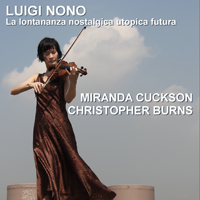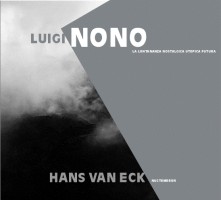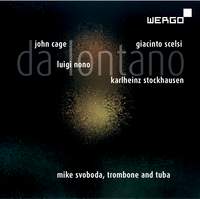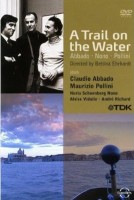Maestro di Suoni e Silenzi: Necessary Nono 4.
|
Grant Chu Covell [June 2014.]
Luigi NONO: La lontananza nostalgica utopica futura (1988-89). Miranda Cuckson (vln), Christopher Burns (electronics). Urlicht-AV UAV-5992-BR (1 CD, 1 Blu-ray) (http://www.urlicht-av.com/). Luigi NONO: La lontananza nostalgica utopica futura (1988-89)1. Hans van ECK: Nuctemeron (2008)2. Tiziana Pintus1 (vln), Hans van Eck1 (sound projection), Schreck Ensemble2: Caroline Erkelens (voice, gong), Tiziana Pintus (vln), Ainhoa Miranda Gimenez (clars), Wilco Botermans (stratifier), Evert de Cock (mixing), Jan-Kees van Kampen, Pieter Suurmond (computers). Sub Rosa SR 309 (1 SACD1, 1 CD2) (http://www.subrosa.net/). After revisiting my comments on La lontananza, I wonder what might attract a violinist to Nono’s diary of a visit with Gidon Kremer. Why might someone want to play precise unidiomatic music – infused with seconds, sevenths, ninths and microtones, all of which sound out of tune – surrounded by hundreds of refracted and manipulated Kremers? As remarked before, Nono prunes away the soloist’s ego. In performance it is highly likely the soloist will be drowned out by the tapes. Further, he or she is instructed to walk about, investigating the performance space’s various acoustics. How many violinists would agree to such conditions? Cuckson and Burns offer the first 5.1 surround sound release of La lontananza (on Blu-Ray but neatly whittled to stereo on an accompanying CD). Given the violinist moves through space, this format makes perfect sense. Cuckson also does something new: She sings along at the unison, octave or fifth at various places. It’s right there in the score. No one else seems to have observed the indication. Her light, hovering voice does help signal when she plays. Cuckson’s violin blends well with the tapes. Burns’ mixing-board work appears to elicit much of the tapes’ extra-musical sounds – Kremer and Nono’s voices, coughing, dragged music stands, things falling…. Virtuosic tidbits seem accidental. Sometimes Burns will isolate one Kremer to taunt Cuckson. Overall Burns prefers a receding tape part, completely at odds with the vigorous Kremer/Gubaidulina assemblage. Not that the market is teeming with La lontananzas, but it does make sense to find a new way. Pintus and van Eck make explicit that the work opens with tapes alone. Sub Rosa divides the 52:46 into seven tracks, naming track 1 Start, Tapes. Tracks 2 to 7 correspond to Leggio 1 through 6. Pintus actively competes with the tapes, unwilling to be obscured. Contrasting with Mellinger/Sciarrino, where Mellinger was distinct, even isolated from the tapes, Pintus sounds projected far forward with the tapes at the periphery. Pintus, laboring to be noticed, doesn’t relish the ponticello and microtones as much as Cuckson. Van Eck tends towards more simultaneous taped violin activity Kremer’s ersatz virtuosic gestures. But there’s plenty of Kremer and Nono’s chatter, and various studio sounds, including a distorted train at the end of Leggio 3. Now and again I hear what might be rapid fader work, leading me to wonder when someone will simply remix the tapes alone. The final violin pitch, duplicated by the tapes, often emerging gradually, here begins like a stab before fading away. The second disc in Sub Rosa’s package (the Nono is on an SACD, the van Eck on a separate CD) offers a concert suite from van Eck’s Nuctemeron, a “hermetic-alchemistic chamber opera.” The original 12 scenes are based upon a mystical text by Apollonius of Tyana (fl. 93 AD). This version collects eight movements corresponding to the 1, 2, 3, 5, 6, 9, 11 and 12th scenes or “hours” of the work with four transitional movements that highlight electronics. The ensemble is soprano, clarinet, violin with electronic activity seeping in from all sides. At first listen, it contradicts Nono in every way possible: goal-directed with clear distinctions between foreground and background. However, it’s clear that the electronics owe something to Nono’s later works. I like listening to Cuckson in Cuckson/Burns and the tape in Pintus/Van Eck. The Cuckson/Burns isn’t the longest realization (56:29), and feels among the lightest and most distant. Pintus/Van Eck actually clocks in as one of the faster ones – the fastest strict reading if discounting Kremer’s own speed-read and modified tape. Nono: La lontananza nostalgica utopica futura (1988-89)
“Da lontano.” Giacinto SCELSI: Mantram – Canto anonimo (1987). John CAGE: Solo for Sliding Trombone (1957-58). Karlheinz STOCKHAUSEN: Signale zur Invasion, I (1993). Luigi NONO: Post-prae-ludium n. 1 per Donau (1987)*. Mike Svoboda (trb, tuba*), Holger Stenschke* (live electronics). Wergo WER 6744 2 (1 SACD) (http://www.wergo.de/). Svoboda’s semi-solo recital unfolds as a sequence of gradually darkening conversations with different composers he’s worked with or recorded before (Scelsi on WER 6672-2, Cage on Wergo WER 6713-2, and Stockhausen’s Tierkreis on Wergo WER 6659-2). At just 44:46 Wergo could have packed a bit more. Xenakis’ Keren or Berio’s Sequenza V would have fit, although the notes state Svoboda was shopping for “pieces which lie outside the ordained list of masterpieces and have been spared the processes of glorification or mummification.” Hello?! This is a solo trombone recital. Who knew there was an ordained list of trombone masterpieces? Scelsi’s brief whimsical vocalise suggests New Orleans. Svoboda produces a limber, occasionally clowning voice. For the Cage, Svoboda multi-tracked the trombone part from the Concerto for Piano and Orchestra (1957-58) to create a stoic and abstract octet. Close listening reveals a squishy canon when the same pitches appear at different tempos and rhythms. At just over 15 minutes, it’s the longest contribution. Wergo’s fine acoustic permits hearing Svoboda wander about for the Stockhausen, a compounding of 126 fanfares from Tuesday from Licht where the trombone/Luzifer battles with the trumpet/Michael. I’ll take this ministration instead of the opera. Svoboda switches to tuba for the Nono. Svoboda ignores others’ recordings and performance practice that surrounds Nono’s late works, deciding instead to pay close attention to the score itself, which he finds remarkably specific. Here too Svoboda offers a monologue even with Stenschke manipulating tape delays. As you’d expect, Nono is more serious than Cage, perhaps even gloomy and violent. There’s a minute-long pedal tone (starting around 7:26), loud and smothering. Repeating the Scelsi dispels the gray mist. Comparing to Klaus Burger on NEOS 11119 (13:39) with the home team, EXPERIMENTALSTUDIO des SWR under André Richard manning the electronics, the tuba burbles as if adrift on an ice floe. Svoboda goes for more texture and a less rarefied atmosphere. Comparing the two, I imagine the work consists of moveable sections, played in any order. Nono: Post-prae-ludium per Donau (1987)
Bettina EHRHARDT: A Trail on the Water (2001). Featuring: Claudio Abbado, Maurizio Pollini, Nuria Schoenberg Nono, Alvise Vidolin, André Richard, et al. Luigi NONO: …sofferte onde serene… (1976). Maurizio Pollini (pno), Alvise Vidolin (sound direction). EuroArts 1052029 (1 DVD) (http://www.euroarts.com/). Circumstances contribute to a strange hour circling around Nono via interviews and footage with his friends, Abbado and Pollini. We learn of the strong bond between the three musicians despite Nono’s absence. Planning for this documentary began in 1990 shortly before Nono’s death. There is no footage of Nono himself, only stills. However, the composer’s music drifts through, often backing splendid footage of Venice, including the ubiquitous canals, San Marco, and exterior shots of the house he was born and died in. There’s a discussion of politics and music and how for many years Nono was prejudged long before any notes sounded. We spy upon Abbado rehearsing Frammento dal Prometeo with André Richard at the controls. In the Salzburg Mozarteum we see Pollini and Vidolin seek the right balance for …sofferte onde serene…. As a bonus, the DVD includes the entire performance. This extra 15-minute short sensibly moves between Pollini’s intense expressions and his hands, which help to delineate the tape’s contributions. The film captures a rehearsal of Schumann’s Piano Concerto on the menu when Abbado and Pollini’s schedules intersected in Carnegie Hall. Abbado rehearsing Schoenberg’s Pelleas und Melisande appears because Nono admired revolutions and revolutionaries, and thus even one of his father-in-law’s Romantic works fits the bill. Pollini and Abbado both say Nono appreciated Mahler (!) which leads to footage of Abbado rehearsing the latter’s Ninth. More relevantly, we see Pollini coaching a Marenzio madrigal sung by the Arnold Schoenberg Choir, music included on the same concert Pollini delivered sofferte. Schumann, Schoenberg, Mahler and Marenzio blended together do not lead inexorably towards Nono. Lacking a clear narrative or a documentary’s direction, the Nono novice might learn that this composer’s music, dissonant and political, is yet somehow concerned with silence. There’s not much about how performers actually feel about Nono or how Nono fits into the 20th century. Abbado and Pollini’s reminiscences, undeniably authentic, are nonetheless indirect, as if the extracted interviews had been caught accidentally even though we suspect they were intentional. Nono would probably have bristled at being made so obscure. As improbable as it may seem, he wanted his music sung in the streets and to reflect the world. [“Improbable” puts it mildly. Ed.]
[Previous Article:
EA Bucket 20.]
[Next Article:
Charlie Haden]
|



